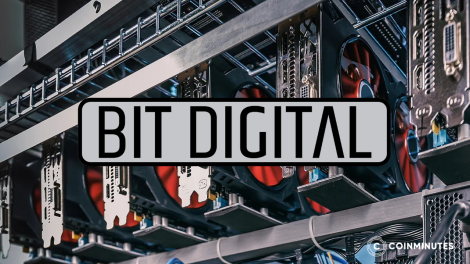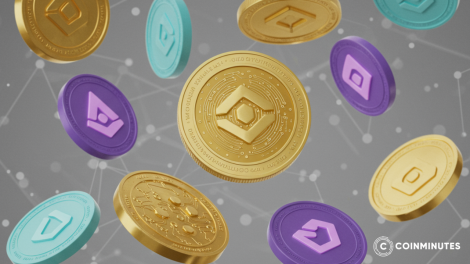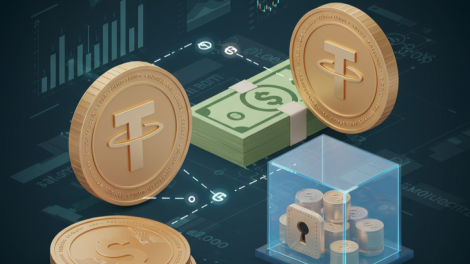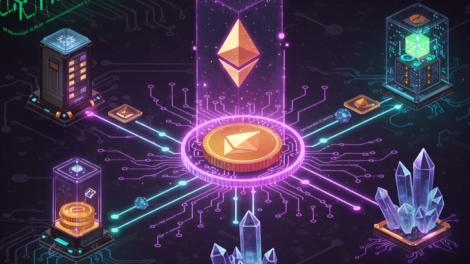What Is Ethereum? Understanding How It Works And What Makes It Different From Bitcoin

Bitcoin showed the world you could have digital money without a bank or a government pulling the strings. But after the initial shock wore off, some folks started thinking: "What else can we do with this blockchain thing?" That’s when Ethereum comes into play. It’s not just about replacing money—it’s about replacing the entire way we use the internet. Join CoinMinutes in this article and discover what Ethereum truly is.
What is Ethereum?
Ethereum is a decentralized blockchain platform that establishes a peer-to-peer network for securely executing and verifying application code. The big idea behind it is that it's programmable. It wasn’t designed just to track who owns what. It was designed to run code. The cryptocurrency of the Ethereum network is called Ether, or ETH.
This makes Ethereum a kind of global, shared computing platform. A "world computer." But instead of being a single machine sitting in a Google or Amazon data center, it's a network made up of thousands of computers (nodes) all around the world, all running the same software, all maintaining a single, shared state of the system. This distributed nature is what makes it decentralized. There’s no central server or any single authority that can dictate how Ethereum operates.

The Ethereum platform was launched in 2015 by Vitalik Buterin and Joe Lubin, founder of the blockchain software company ConsenSys. It took the core concept of a blockchain—a secure, immutable public ledger—and added a crucial ingredient: smart contracts. These self-executing pieces of code allow developers to build far more complex applications than simple monetary transactions. This programmability is what turned the blockchain from a simple ledger into a platform for innovation, giving birth to massive new sectors like Decentralized Finance (DeFi) and Non-Fungible Tokens (NFTs).
How Does Ethereum Work?
So how does this "world computer" actually run? It’s not one machine, but it acts like one. It all comes down to a few core components working in concert, a symphony of distributed consensus and code execution.
The Blockchain Foundation
At its heart, Ethereum is a blockchain, just like Bitcoin. It's a continuously growing chain of "blocks," where each block contains a batch of transactions. Every participant (node) in the network keeps a copy of this entire ledger. This massive redundancy is what makes it secure and censorship-resistant.
The big difference in how the foundation works, especially after "The Merge" upgrade in 2022, is its consensus mechanism. Ethereum moved from Proof-of-Work (the energy-intensive mining system Bitcoin uses) to Proof-of-Stake (PoS).
Proof-of-Stake allows "validators" lock up a certain amount of their own ETH (at least 32 ETH) as collateral (their stake). These validators are then randomly selected to propose new blocks of transactions. Other validators check their work and attest that the block is valid. If a validator acts honestly, they earn a reward in new ETH. If they try to cheat or are negligent, a portion of their staked ETH can be destroyed ("slashed"). This creates a powerful economic incentive to play by the rules. The switch to PoS drastically reduced Ethereum's energy consumption, a major point of criticism in the PoW era.
Smart Contract
This is the key innovation Ethereum brought to the party. A smart contract is just a program that runs on the Ethereum blockchain. The "smart" part is that it’s self-executing and tamper-proof once deployed. It runs exactly as programmed, based on "if-then" logic, without any possibility of downtime, censorship, or third-party interference.
Think of a vending machine. It's a very simple smart contract. If you insert the correct amount of money and press the button for a specific snack, the machine will automatically dispense that snack.
There's no need for a cashier. The rules are baked into the machine. A smart contract on Ethereum is the same idea, but for digital assets and information. It’s an agreement written in code that automatically enforces its own terms. These contracts are what allow for the creation of all the complex applications built on Ethereum.
Decentralized Applications (DApps)
Once you have smart contracts, you can build Decentralized Applications, or DApps. A dApp is like any other app on your phone or computer, but its backend logic—the important stuff—is run by smart contracts on the Ethereum blockchain instead of on a centralized server owned by a company like Google or Facebook.

A dApp has a front-end (a website or mobile interface) that users interact with. When a user performs an action, the front-end sends a transaction to the backend smart contracts on Ethereum.
Because the backend is decentralized, dApps are incredibly resilient. They can't be shut down by a single entity. The rules of the app are transparent and verifiable by anyone who cares to look at the smart contract code.
The Ethereum Virtual Machine (EVM)
This is the heart of the Ethereum world computer. The Ethereum Virtual Machine (EVM) is the environment where all smart contracts are executed. It’s not a physical machine, but a virtual one—a specification that is implemented by every full node in the Ethereum network.
The EVM’s job is to process and execute the smart contract code. When a transaction is sent to a smart contract, every node on the network runs that transaction through its instance of the EVM.
Because every node runs the same EVM and processes the same transactions, they all arrive at the exact same end result. This is how the network maintains a single, shared "state" or ledger. The EVM is the sandboxed environment that ensures the network stays in consensus. It’s what makes sure that when you interact with a smart contract, the outcome is predictable and consistent across the entire globe.
The EVM is "turing-complete," which is a fancy way of saying it can compute anything that any other computer can compute. This is what gives Ethereum its flexibility and power to support a vast range of different applications. It’s a true general-purpose computing environment.
Ethereum vs. Bitcoin: The Key Differences
Ethereum and Bitcoin are two powerhouses of the crypto world. People love to pit them against each other, but in many ways, they’re playing different games. Understanding their differences is key to understanding the crypto landscape. It's not about which one is "better"—it's about what they were built to do.
Original Purpose and Philosophy
-
Bitcoin: Satoshi Nakamoto designed Bitcoin to be "a peer-to-peer electronic cash system." Over time, its narrative has solidified around it being a store of value, or "digital gold." Its philosophy is one of simplicity, robustness, and sound money, enforced by a hard cap of 21 million coins.
-
Ethereum: Vitalik Buterin and the other co-founders designed Ethereum to be a platform for building decentralized applications. Its philosophy is about programmability, flexibility, and utility. It wasn't meant to be just money; it was meant to be the foundation for a new, decentralized web.

Technical Differences
-
Consensus Mechanism: Bitcoin uses Proof-of-Work (PoW), which is secured by massive energy expenditure from miners. Ethereum now uses Proof-of-Stake (PoS), which is secured by validators staking their own ETH. PoS is vastly more energy-efficient.
-
Monetary Policy: Bitcoin has a fixed, predictable supply capped at 21 million BTC. This enforces digital scarcity. Ethereum has no hard supply cap. New ETH is issued to reward validators, but a portion of transaction fees are also "burned" (removed from circulation) via a mechanism called EIP-1559. This can sometimes make ETH's supply deflationary, but its policy is flexible and designed to secure the network rather than create absolute scarcity.
-
Block Time: A new block is added to the Bitcoin blockchain roughly every 10 minutes. On Ethereum, it's roughly every 12 seconds. This allows for faster transaction confirmation times on Ethereum's base layer.
Smart Contracts and Programmability
This is the most fundamental difference.
-
Bitcoin: Bitcoin has a very limited scripting language. It's deliberately not "Turing-complete." This was a design choice to maximize security and simplicity and reduce the potential attack surface. You can do some simple smart contracts, but it's not its main purpose.
-
Ethereum: Ethereum was built specifically for smart contracts. Its virtual machine (the EVM) is Turing-complete, meaning it can run programs of arbitrary complexity. This is what allows for the entire universe of DeFi, NFTs, and dApps to be built on top of it.
Network Ecosystem
The different philosophies lead to vastly different ecosystems.
-
Bitcoin: The ecosystem is primarily focused on Bitcoin as a monetary asset. It includes wallets, exchanges, payment processors, and Layer 2 solutions like the Lightning Network, which is designed to make payments faster and cheaper.
-
Ethereum: The ecosystem is a sprawling, chaotic, and innovative jungle of thousands of applications. It includes decentralized exchanges, lending platforms, stablecoins, NFT marketplaces, blockchain games, prediction markets, DAOs, and more. It’s a platform for experimentation.
Value and Investment Perspectives
Because of their differences, people view them through different lenses.
-
Bitcoin: Often seen as a long-term store of value, a hedge against inflation, or a digital commodity. People talk about it in terms of "digital gold."
-
Ethereum: Often seen as a productive asset or a tech investment. The value of ETH is tied to the demand for the Ethereum network. To use dApps, you need ETH to pay gas fees. To secure the network, you need to stake ETH. This gives it a utility value beyond just being money. Some call it "digital oil"—the fuel that powers the world computer. This is a topic often dissected on crypto analysis platforms like CoinMinutes.
The Future of Ethereum
Ethereum is far from a finished product. It's undergoing a series of ambitious upgrades designed to make it more scalable, secure, and sustainable. This roadmap, once known as "Ethereum 2.0," is now being rolled out in phases.
-
Increased Scalability (The Surge): The biggest challenge for Ethereum has been scalability. High demand can lead to network congestion and high gas fees. The next major upgrade phase focuses on implementing "danksharding," a technology that will dramatically increase the network's capacity to process transactions. The goal is to handle thousands of transactions per second, making the network cheaper and faster for everyone.
-
Layer-2 Scaling Solutions: While the main network is being upgraded, an entire ecosystem of "Layer-2" solutions has emerged. Think of them as express lanes built on top of Ethereum's main highway. Platforms like Arbitrum, Optimism, and Polygon process transactions on their own chains and then settle them in batches on the main Ethereum network. This takes the load off the mainnet and offers users near-instant, low-cost transactions. The future of Ethereum is a modular one, where Layer-1 provides security and Layer-2s provide scale.
-
Wider Mainstream Adoption: As the technology matures and becomes easier to use, we can expect to see DApps that feel just like the web apps we use today, but with the added benefits of decentralization and user ownership. Imagine social media where you control your data, or financial products accessible to anyone with an internet connection, without a bank. This is the future Ethereum is building toward.
The big picture for the future is clear: Ethereum's Layer 1 will increasingly serve as a highly secure, decentralized settlement layer—a global consensus and data availability engine. The bulk of user activity, the millions of daily transactions, will happen on Layer 2s. The challenge will be to make this multi-layered system seamless and easy for users to navigate, while also fending off competition from other, newer smart contract platforms like Solana that promise high scalability on their base layer. The journey is far from over.
The Bottom Line
Ethereum took the idea of a blockchain and supercharged it. It created a platform, a world computer that anyone can pay to use. It’s the foundation for a new, decentralized digital economy. Its ambition is its greatest strength, enabling incredible innovation in finance and digital ownership.
Ethereum is a sprawling city under permanent construction. It's noisy, chaotic, and dangerous in parts. But it's where all the building is happening. It's not just a bet on a new kind of money. It's a bet on a new kind of internet. And that's a much bigger, much stranger bet to make.
 English
English
 Vietnamese
Vietnamese
















